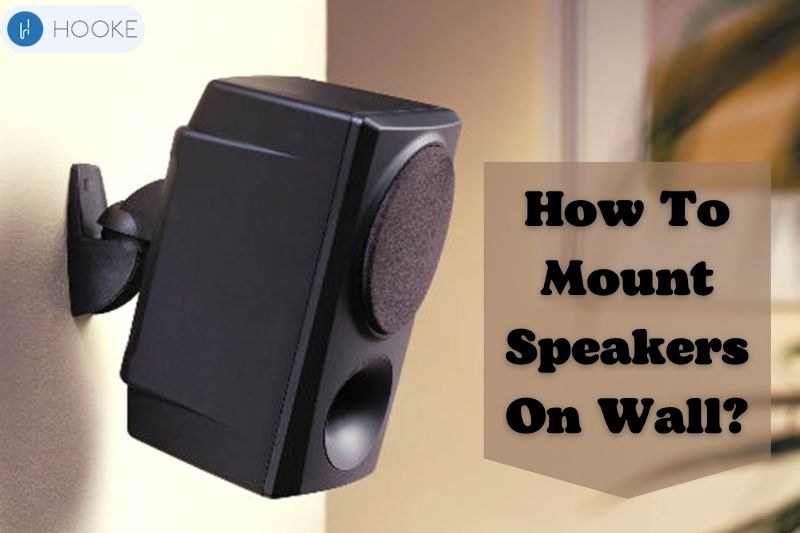Wall-mounted speakers may provide a high-quality audio experience in your house.
Mounting speakers on the wall makes the sound better, saves space, and makes the room look better.
To put speakers in a way that is safe, makes sense, and gives good sound, planning and execution are needed.
Hookeaudio will give a guide on how to mount speakers on wall, as well as tips on how to choose the best speaker, place it, and keep the wires organized.
Contents
Why Should You Wall Mount Speakers?
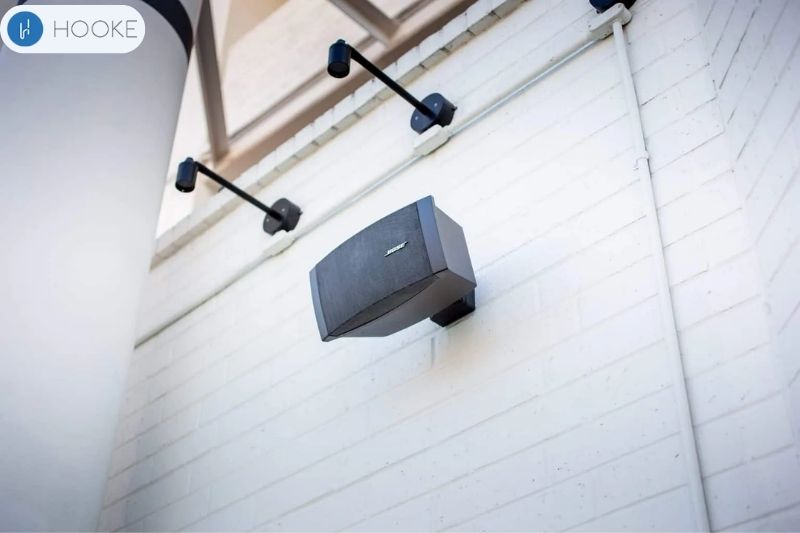
Wall-mounting speakers can enhance the overall listening experience in several ways.
Hanging speakers on the wall optimizes their height and angle for sound quality. This improves sound clarity and immersion.
Wall-mounted speakers are great for small rooms or homes because they take up less floor space than freestanding speakers. They blend nicely with the wall and don’t take up floor space, making them appealing home decor.
Wall-mounted speakers are less likely to be pushed over or hit, protecting them and the room.
Wall-mounted speakers improve sound quality, make a room look more modern, and give you more placement and setting options.
How to Mount Speakers On Walls?
Step 1. Choose The Right Mount
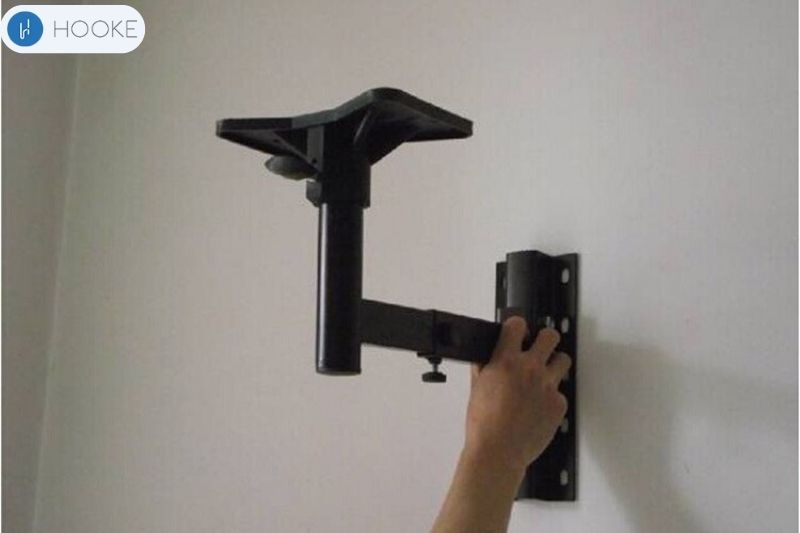
When choosing a mount to mount speakers on walls, it is important to consider several factors. Speaker mounts depend on speaker size and weight.
Different speaker mounts are built for different types of walls, so you need to consider that. Some mounts are for drywall, others for concrete or brick.
The mount’s tilt and swivel features let you orient the speakers for best sound quality.
Lastly, you need to consider the aesthetics of the mount, as you want it to blend in with your room’s decor.
Step 2. Identify The Right Location
After choosing the proper mount to mount your speakers on walls, choose the right place.
Sound quality and listening experience depend on speaker placement. To get the optimum sound dispersion and balance, arrange the speakers.
One way to determine the right location is to use the “rule of thirds.” Divide the wall into three equal parts both vertically and horizontally, and put the speakers at the intersections.
To guide sound to the listener, put the speakers at ear level when seated.
Finally, mount the speakers securely to avoid accidents or damage.
Step 3. Mount The Brackets
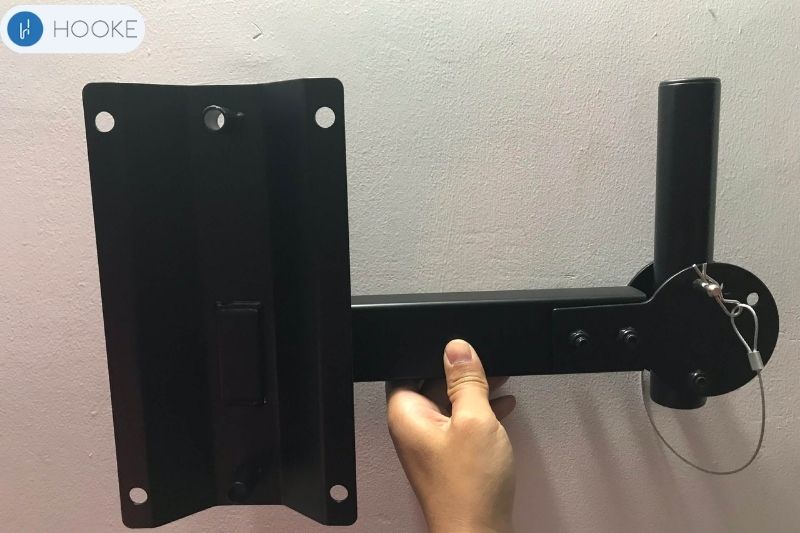
Once you have chosen the right mount and identified the ideal location to mount your speakers on walls, the next step is to mount the brackets.
To do this, you will need a power drill, drill bits, screws, and a screwdriver. Here are the steps to follow:
- Place the mount on the wall: Hold the mount against the wall and mark the screw holes with a pencil.
- Drill pilot holes: Use a drill bit that is slightly smaller than the screws to drill pilot holes where you made the marks.
- Attach the brackets: Place the brackets on the mount and insert screws into the pilot holes. Use a screwdriver to tighten the screws until they are secure.
- Test the brackets: Test the brackets to make sure they are securely mounted and can support the weight of your speakers.
- Attach the speakers: Install the speakers on the brackets according the manufacturer’s directions. Some mounts feature a screw hole on the back of the speaker, while others require a plate.
These steps will firmly mount the brackets and attach your speakers to the wall for best sound quality and aesthetics. To avoid accidents and speaker damage, attach the brackets securely.
Step 4. Mount The Speakers

Once the brackets are securely mounted, the final step is to mount the speakers onto the brackets. Here are the steps on how to hang speakers on wall:
- Align the speakers: Place the speakers on the brackets and make sure they are aligned correctly. Some installations employ screws or bolts to secure the speakers, while others include a locking mechanism.
- Test the speakers: Check the speakers to make sure they are fixed well and don’t move around. You can gently push on the speakers to make sure they are stable and will not fall off the brackets.
- Adjust the speaker angle: For best sound, tilt or swivel your mount’s speakers. You may need to try different angles to position your speakers.
- Connect the wiring: Follow the directions from the speaker maker to connect them to your audio source or amplifier. Make sure the wires are securely connected and not loose.
- Test the sound: Test the sound to ensure the speakers are working properly and providing optimal sound quality. Adjust the volume and other settings as needed to optimize your listening experience.
What to Consider Before Mounting Speakers On The Wall
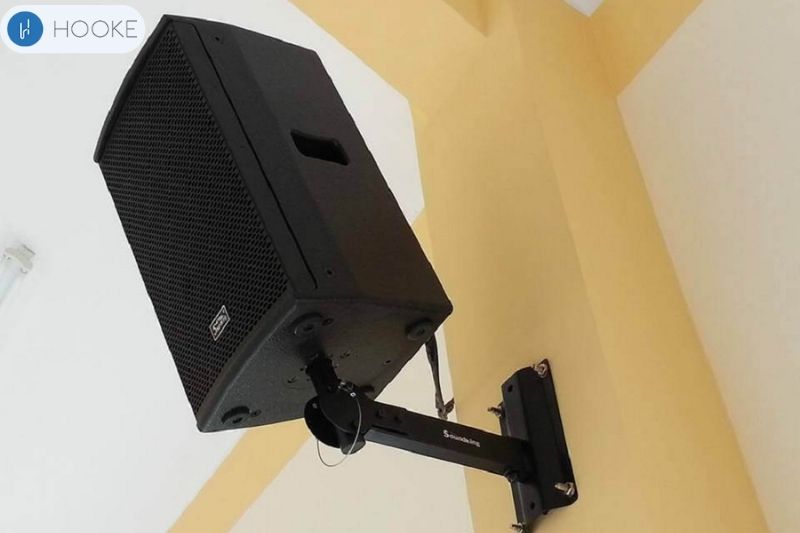
Speaker wall mounting type
Before mounting your speakers, choose a speaker wall mount. Different speaker wall mounts have pros and cons. Here are some of the most common types of speaker wall mounts to consider:
- Fixed speaker mounts: These mounts keep speakers in place without tilting or swiveling. The cheapest and easiest to install, they may not be as flexible as other mounts.
- Tilt and swivel mounts: These mounts allow you to adjust the angle of the speakers for optimal sound quality. They are ideal for larger rooms where you may need to adjust speaker angles to optimize sound.
- Ceiling mounts: If you have high ceilings or limited wall space, ceiling mounts may be a good option. These mounts let you put speakers on the roof and change their angle for the best sound.
- Articulating mounts: These mounts allow for the most speaker angle and position adjustments. They cost the most and may be harder to install than other mounts.
Consider your preferences when picking a speaker wall mount. Choose a mount based on your speakers’ weight, room size, and budget.
Room space
Consider your room’s size and layout before wall-mounting your speakers. Speaker placement and mount type depend on room size.
In a tiny room, a fixed installation that holds the speakers in place and doesn’t take up much space may be best.
In a large room, a mount that tilts and swivels the speakers may improve sound quality.
You should also consider the speaker-listening area distance. For maximum sound quality, set speakers at ear level and equidistant from your listening location.
Cable management
Cable management is crucial when putting speakers on the wall to hide cords and maintain the room’s appearance.
Running cables through the wall entails cutting holes and running them behind the drywall. This alternative has a smooth, seamless look but is harder to install and may require an expert.
Cable raceways are plastic or metal channels that can be installed on the wall to hide cables. This method is simpler and cheaper than routing cables through the wall.
To organize cables, use cable ties or clips to attach them to the wall or baseboard.
Speaker types and their location
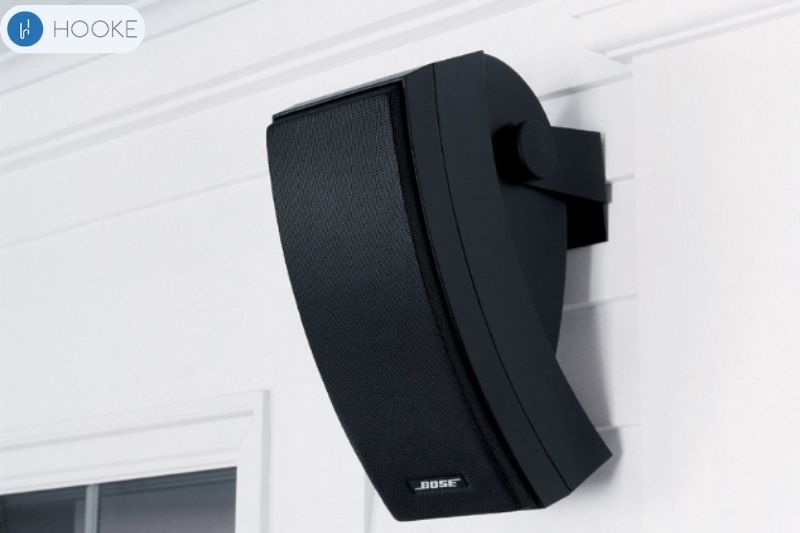
For optimal sound, different speakers may need different mounting places. For example:
- Bookshelf speakers: These compact speakers can be wall-mounted or put on a shelf or bookcase. They are typically best suited for smaller rooms or as part of a surround sound system.
- Floor-standing speakers: These floor-standing speakers are great for larger spaces or home theaters.
- In-wall or in-ceiling speakers: These speakers are mounted directly into the wall or ceiling and are designed to be flush with the surface. They are typically best suited for whole-house audio systems or for use in rooms where you want the speakers to be less visible.
Consider room size, layout, and listening area before placing speakers. For maximum sound quality, set speakers at ear level and equidistant from your listening location.
Try multiple speaker positions to find the optimum fit for your speakers and room.
Wall stud placement
Nailer placement is an important consideration when mounting speakers on the wall. Studs are the vertical supports behind the drywall that provide strength and stability to the wall.
Anchor heavy items like speakers to the studs to prevent them from falling or damaging the wall.
Before mounting your speakers, you should locate the studs in the wall using a stud finder. Once you have located the studs, you can determine the best location to mount your speakers.
In general, it’s best to mount your speakers directly to the studs rather than using anchors or drywall alone, as this will provide the most secure and stable mount.
If the studs are not in an ideal location for mounting your speakers, you may need to use a mounting bracket or other hardware to attach the speakers to the wall.
However, it’s important to ensure that the bracket or hardware is also securely attached to the studs to prevent damage to the wall or the speakers.
Speaker size and weight
Speaker size and weight are important considerations when mounting speakers on the wall. Larger speakers need additional support and a stronger mounting method.
The mount’s weight capacity should match your speakers’ weight when choosing a mounting method. Larger speakers need stronger mounts.
When mounting speakers, consider their size and wall space. Some mounts are built for specific speaker sizes or shapes, while others can fit a variety of speakers.
What are The Speaker Types to Mount Inside or On A Wall?

Front speakers
The front speakers deliver most of the sound and are usually the largest and most powerful.
They should be mounted on either side of the TV or screen at proper level for optimum sound quality. This ensures that the sound is directed toward the viewer and provides an immersive experience.
In some cases, the front speakers can also be mounted on the wall behind an acoustically transparent screen
The center speaker
The center speaker is responsible for dialogue and other central sound effects in movies and TV shows.
It should be positioned directly above or below the TV or screen and aimed directly at the listener. This ensures that the audience hears clear dialogue.
The subwoofer
Low-frequency noises and richness are produced by the subwoofer.
It works best near a corner or wall, although it may be positioned elsewhere in the space. Some subwoofers have mounting brackets for wall mounting.
The surrounds or rear speakers
The surround or rear speakers are responsible for providing ambient sound and sound effects in a home theater system.
They are typically mounted on the side or rear walls of the room, at suitable level, and angled slightly toward the viewer. This provides an immersive audio experience and helps to create a sense of space and depth.
FAQs
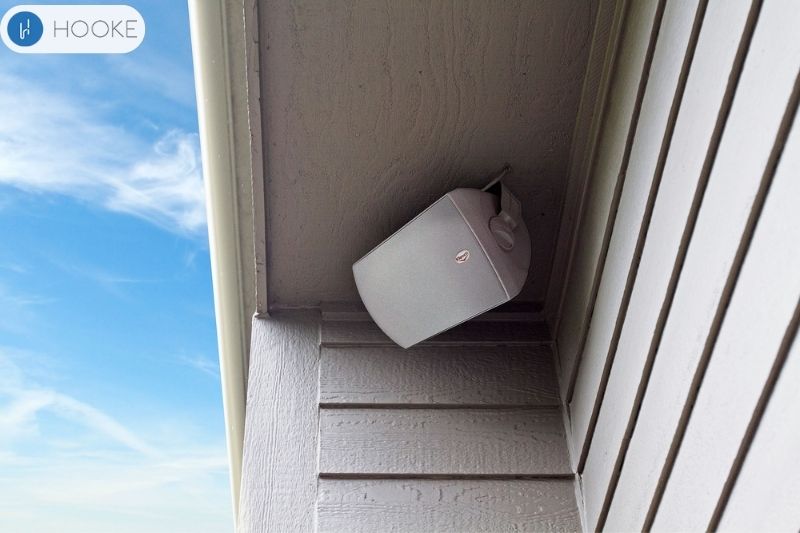
What Do You Use To Mount Speakers On A Wall?
Brackets, wall mounts, and speaker stands can be used to wall-mount speakers. Speaker type, size, position, and wall material determine mounting hardware.
How Do You Secure Speakers To The Wall?
To secure speakers to the wall, you can use mounting brackets or wall mounts designed for the specific type and size of your speakers. The mounting hardware should be screwed into nailers or anchors to ensure a secure attachment.
How Do You Mount Speakers On The Wall Without Drilling Holes?
It’s difficult to mount speakers on the wall without drilling holes as drilling is the most secure method of attachment. However, some alternatives include using adhesive strips, hooks, or mounting putty. These options may not be as secure as drilling, and the adhesive may not work on all surfaces.
Is It A Good Idea to Wall-mount Speakers?
Wall mounting speakers can be a great idea as they can help to improve sound quality, save space, and enhance the overall aesthetic of your space. However, ensure to take into consideration several factors such as room space, speaker size and weight, sleeper placement, and cable management before proceeding with the mounting process.
Can I make a RP-600m wall mount?
Yes, you can make a wall mount for the RP-600M bookshelf speakers. There are various tutorials and guides available online that can help you make a wall mount for these speakers.
However, it’s important to ensure that the wall mount you create is sturdy and safe to use. If you’re unsure about your DIY skills or the safety of your mount, it may be better to purchase a pre-made wall mount specifically designed for the RP-600M speakers.
Read more:
- Best In Wall Subwoofers
- How Long Do Speakers Last?
- How To Wire Speakers With 4 Terminals?
- How To Make All Speakers Work On Surround Sound 2023
Conclusion
Whether you’re installing a home theater system, whole-house audio, or just want high-quality sound, wall-mounting speakers can improve your audio experience.
Before mounting, consider room size, speaker weight, wall stud placement, and cable management.
This guide will teach you how to wall mount speakers and get the best sound.

